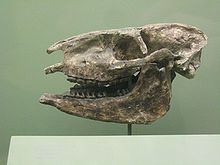- Miohippus
-
Miohippus[1]
Temporal range: late Eocene to early Miocene.
Miohippus Fossil skull Scientific classification Kingdom: Animalia Phylum: Chordata Class: Mammalia Order: Perissodactyla Family: Equidae Subfamily: †Anchitheriinae Genus: Miohippus
Marsh, 1874Miohippus (meaning "small horse") was a genus of prehistoric horse existing longer than most Equidae. Miohippus lived in what is now North America during the Oligocene approximately 32-25 million years ago. While descending genera of this species lived during the Miocene period, the Miohippus was a horse of the Oligocene. According to the Florida Museum of Natural History, Othniel Charles Marsh first believed Miohippus lived during the Miocene and thus named the genus using this incorrect conclusion. More recent research provides evidence that Miohippus actually lived during the Oligocene.
Miochippus species are commonly referred to as the three-toed horses. Their range was from Alberta, Canada to Florida to California.
Contents
Taxonomy
Miohippus was named by Marsh in 1874 and its type is Miohippus annectens. It was assigned to Equidae by Marsh in 1874. It was synonymized subjectively with Mesohippus by Matthew in 1899. It was assigned again by Hay (1902), H. F. Osborn in 1918,[2] Hay (1930), Stirton (1940) and Carroll (1988); and to Anchitheriinae by MacFadden in 1998.[3]
Species
- M. anceps
- M. annectens syn. with M. crassicuspis
- M. assiniboiensis
- M. condon
- M. equiceps syn. with Anchitherium brachylophus
- M. gemmarosae
- M. gidleyi (syn. with Mesohippus grallipes, Mesohippus validus)
- M. grandis
- M. intermedius
- M. longicristis
- M. obliquidens syn. with Mesohippus barbour, Mesohippus brachystylus, Mesohippus eulophus, M. meteulophus, Pediohippus antiquus
- M. primus
- M. quartus
Morphology
Three specimens were examined for estimated body mass by M. Mendoza, C. M. Janis, and P. Palmqvist.[4] These specimens were estimated to weigh:
- 13.5 kg (30 lb)
- 32.7 kg (72 lb)
The species M. obliquidens dating from 34.9 to 30.0 Ma found in Montana, North Dakota, South Dakota, and Nebraska when calculated for estimated body mass were within the margin of 25 to 30 kg.
Mesohippus became much larger than Miohippus. They weighed around 40 to 55 kilograms. They were somewhat larger than most earlier Eocene horse ancestors, but still much smaller than modern horses, which typically weigh about 500 kilograms.
Miohippus was larger than Mesohippus and had a slightly longer skull. Its facial fossa was deeper and more expanded, and the ankle joint was subtly different. Miohippus also had a variable extra crest on its upper molars, which gave it a larger surface area for chewing tougher forage. This would become a typical characteristic of the teeth of later equine species.
Miohippus had two forms, one of which adjusted to the life in forests, while the other remained suited to life on prairies. The forest form led to the birth of Kalobatippus (or Miohippus intermedius), whose second and fourth finger again elongated for travel on the softer primeval forest grounds. The Kalobatippus managed to relocate to Asia via the Bering Strait land bridge, and from there moved into Europe, where its fossils were formerly described under the name Anchitherium. Kalobatippus is then believed to have evolved into a form known as Hyohippus, which became extinct near the beginning of the Pliocene.
See also
References
- ^ McKenna, M. C, and S. K. Bell (1997). Classification of Mammals Above the Species Level. Columbia University Press. ISBN 023111012X.
- ^ H. F. Osborn. 1918. Geological Society America Bulletin 29.
- ^ B. J. MacFadden. 1998. Equidae. In C. M. Janis, K. M. Scott, and L. L. Jacobs (eds.), Evolution of Tertiary Mammals of North America 1:537-559.
- ^ M. Mendoza, C. M. Janis, and P. Palmqvist. 2006. Estimating the body mass of extinct ungulates: a study on the use of multiple regression. Journal of Zoology 270(1):90-101.
- Evolution of the Horse
- Horse Evolution, by Kathleen Hunt
- Evolution of Horses
Categories:- Prehistoric horses
- Eocene mammals
- Oligocene mammals
- Oligocene extinctions
Wikimedia Foundation. 2010.


